The No-Stilettos Rule
or,
My Philosophy as A Woman SFF Art Director
-By Lauren Panepinto
I’ve been writing a column about the business side of art for over two years. In all that time I have tried my best to give artists a look under the hood, as it were, and see things from an Art Director’s point of view. I have tackled many a difficult topic as clearly and fairly as I could, and over those two years I built up a trust between myself and my readers. It wasn’t until I felt like that strong relationship had been established that I believed I could start talking about how being a woman affects my experience in art and in geekdom. Because it does. And I think it’s valuable to explain exactly how, in the hopes that it will give people a window into understanding these big issues on a more personal level. I believe in empathy, and telling your story so other people can feel your POV.
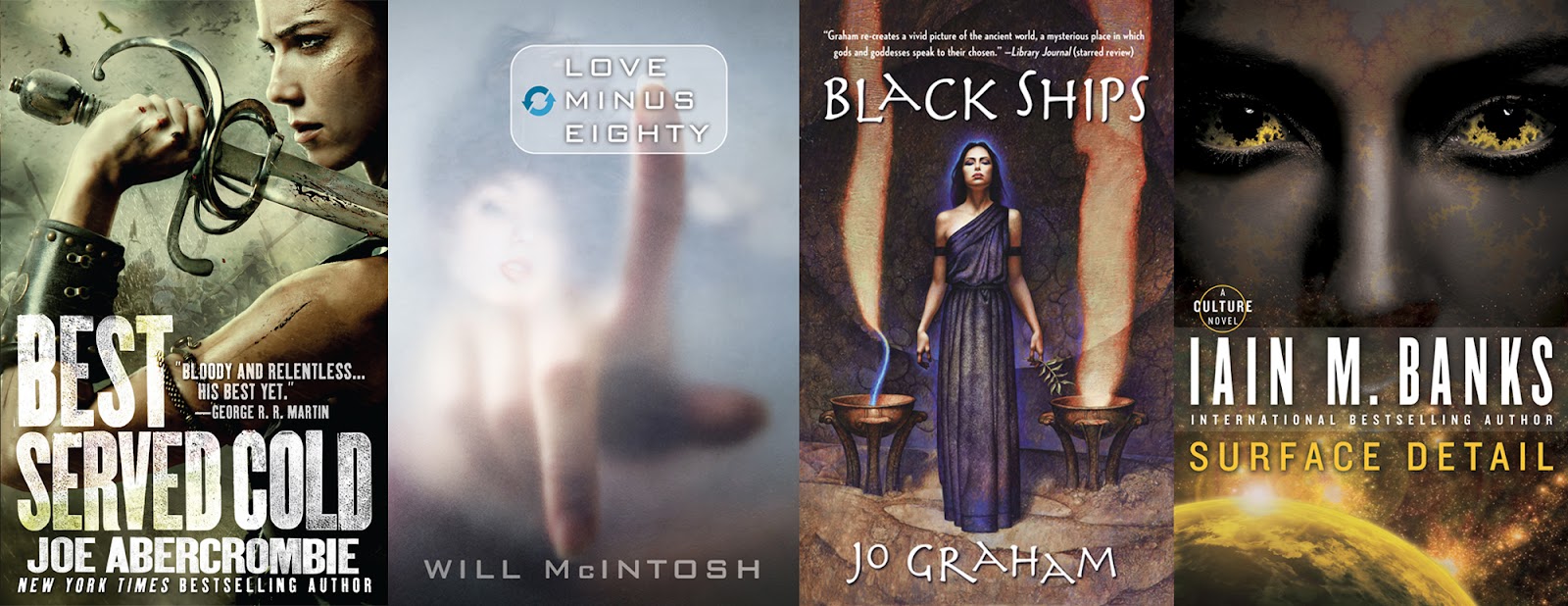 |
| Women of Orbit Covers: Epic Fantasy, SciFi, Historical Fantasy |
As I explained in my last post, Women’s History Month seemed like a good time to talk about these issues, and I’d like to keep the ball rolling and keep talking, because they aren’t going away. Women Artists are speaking out against injustices in the art world. Social Media has been a gender-issue battlefield this year. I really believe we are finally at the watershed moment where female fans of comics, games, and SFF books are not content to sit idly by while their desires and needs are dictated to them. They want a say in the creation of material designed specifically for them. And companies are starting to listen. Artists are learning that they need to take their changing target audiences into account, not just assume they are the same as five, ten years ago. I believe this is an important evolution. Women fans do not want to “ruin” anyone’s fun. There are plenty of places for a male POV and enjoyment of sexual objectification. I absolutely do not think those places need to be eliminated. But places that are meant for an audience of women need to consider the desires of those women. This will make art and geek media a better, more inclusive place. I know this, because it is what I have been doing, quietly, at Orbit Books for years.
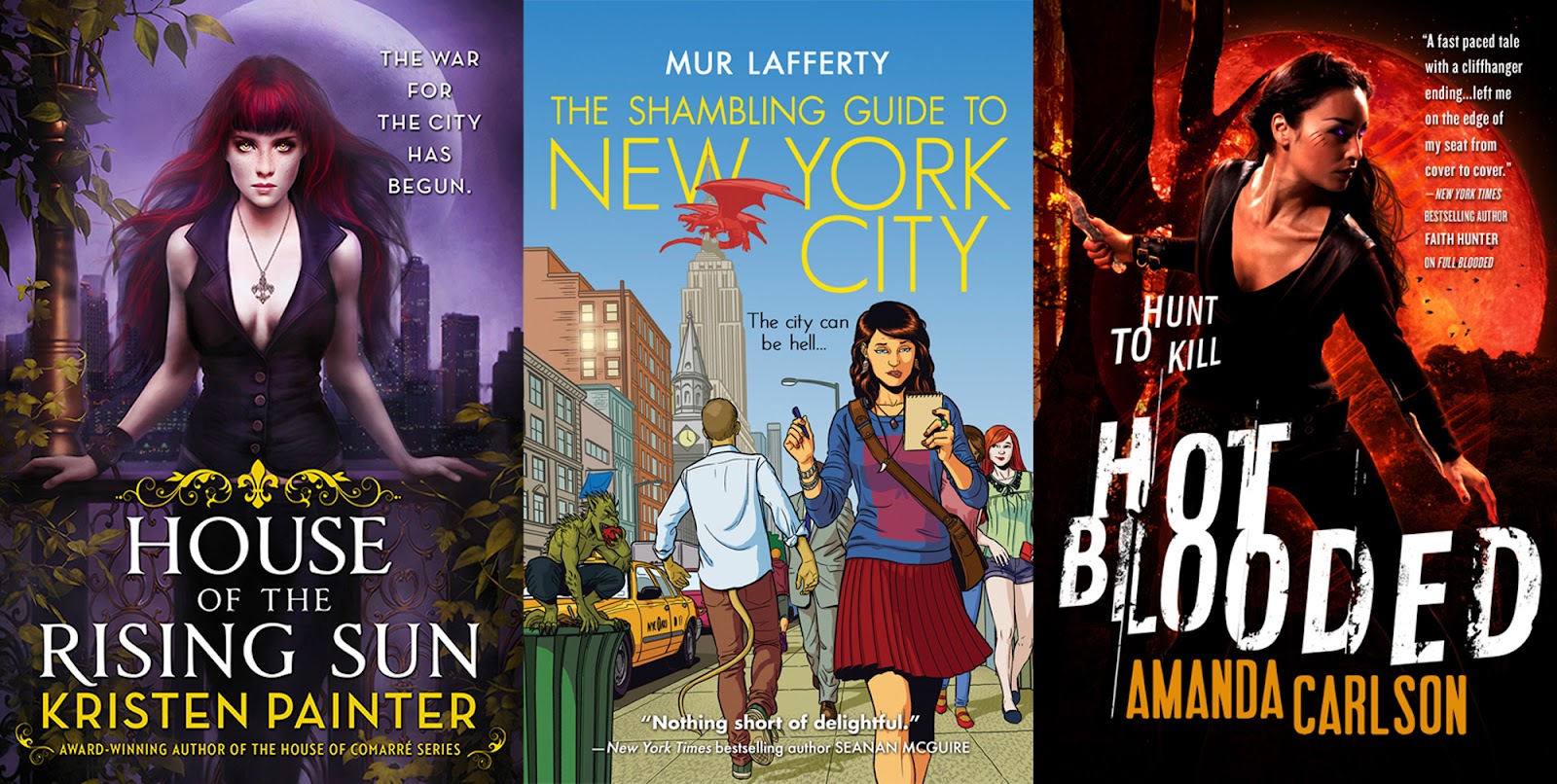 |
| Women of Orbit Covers: Urban Fantasy |
As I have said before, I grew up a geek. Star Wars, Wonder Woman, Voltron, Thundercats, He-Man—the list goes on and on. I was a typical tomboy, but I was still a girl. And I inserted myself into the geek media primarily made for boys via the female characters. The more badass, the better. I adopted into my identity the snark of Princess Leia and the strength of Wonder Woman. You can trace my entire history as a geek through the strong female characters there—but it was always a beggar’s banquet. Though this was way before the Bechdel Test, almost all the media I consumed would have failed miserably. And as I got to the age that I was noticing—then struggling to understand—male sexual attention and my own sexual identity, all those strong female characters seemed to be sending mixed signals. This is worthy of a post in itself, of course, but lets just say it was confusing to me when a woman character lauded for her strength and intellect and heroism would be dumb enough to fight her enemies in a bathing suit. With her hair down where anyone could grab it. Hell, I think I cheered when Jean Grey got pockets. My problem wasn’t with a character being sexy. I had a problem when the things that made them sexy were in direct contradiction to how strong or smart they were. It made them feel less real, and harder for me to fit myself into. So was sex a strength? Did it “distract the guys” as the age-old argument goes? Or was it a punishment? It took a long time for me to understand the difference between sexuality and sexual objectification. (Cliff Notes Version: It’s all about agency.) Here’s a great video overview for you.
Because this is an important distinction (and because I’m tired of hearing the “girls just want to cover everyone up” argument) let me illustrate this delicate point with a master who also happens to have painted a LOT of naked women. Often guys are surprised to hear I love Frazetta. I’m not bothered at all by most of his barely-clad ladies. He understood agency. When he objectified his women, it was by design, and you can clearly see the difference below:
 |
| Naked ladies as trophies, prizes, ornamentation. They don’t have stories, they are objects that the action happens to |
 |
| Just as naked, but with 100% more agency. They have stories to tell. They are not objects to be won |
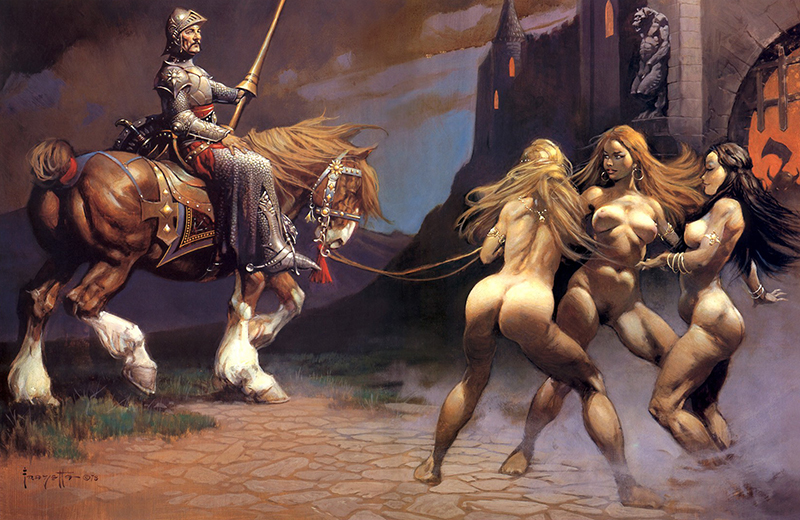 |
| And now Frazetta is turning the stereotype on it’s head – once trophies, now the women are dominant, taking agency back from their captor |
So how does all this affect what I do as a professional Art Director?
Artists know, you cannot make art without bringing a piece of yourself to it. Even if you are illustrating someone else’s story, you have to relate to it in some way before you can translate it into a visual. It is critical to what I do that I bring my geek history to my work at Orbit. I have to translate each manuscript not only into a good visual, but a visual that fits itself into the history of all the covers in that genre that have gone before. I need to know the trends in space opera, in science fiction, in epic fantasy—and then decide how much I am going to let the trends dictate, or how much I am going to push at those stylistic boundaries.
Along with knowledge of the genre comes consideration of the target audience, and gender has a huge role to play. Every time I ask myself who the target audience is for a book, I have to know if it’s aimed at a predominantly male audience, a predominantly female audience, or equal parts male and female. People ask me if the author’s gender plays a large role in how we package the book, and I am proud to say at Orbit, it does not. I am encouraged to create a package that is best for the manuscript and the target audience first and foremost.
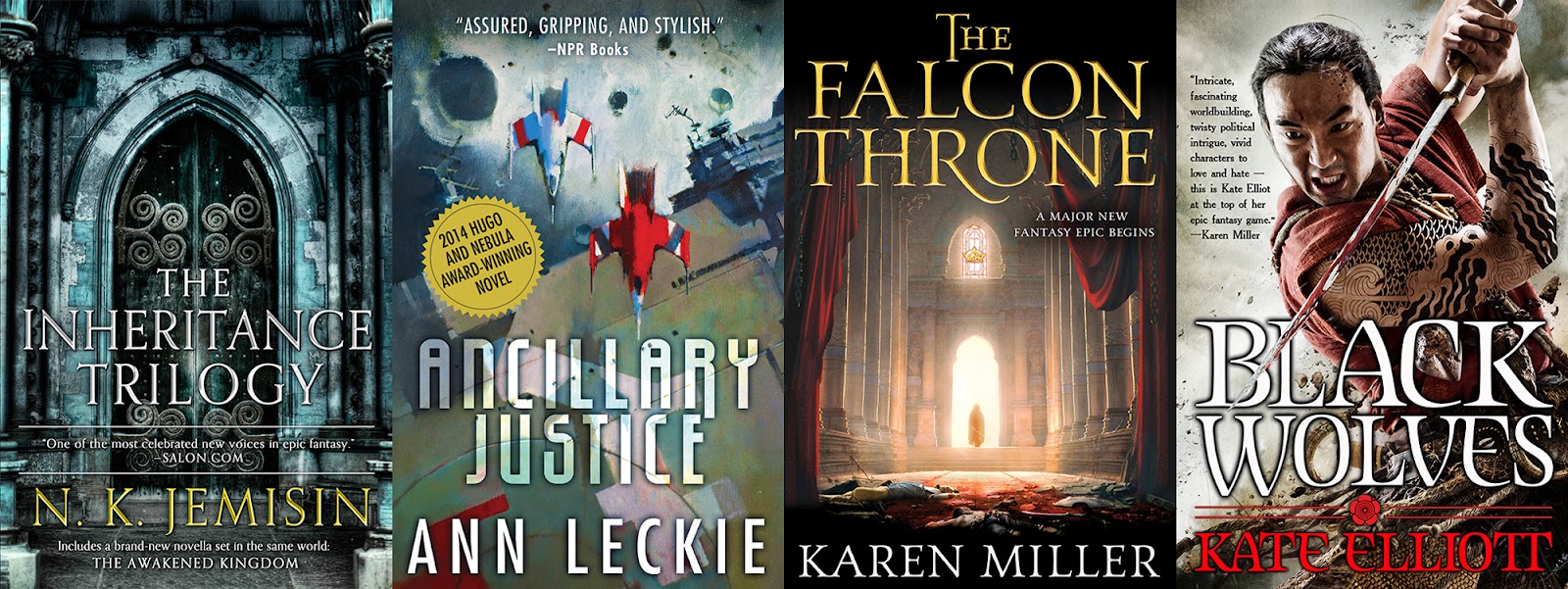 |
| Recent covers of some of Orbit’s most popular women authors |
Although target audience affects all books, I’m going to dive deeper into one genre where it is absolutely critical—Urban Fantasy. This is the genre where we most frequently show characters on the covers, and the target audience is overwhelmingly women. It’s also the genre where the covers get the most abuse for stereotypically having a hot woman on the cover with a gun, a bared midriff, and a bad tramp stamp tribal tattoo. The fans roll their eyes. the authors complain. People even make fun of the covers for charity. So what’s going on here? If women are the target audience, how are these books ending up with objectified covers? I think there’s a lot of overlap with similar issues in how women are portrayed in comics and gaming. However, as I said, the target audience is primarily women. So it sets aside the whole aspect of comics and gaming historically being a male-dominated media for now.
 |
| Orbit Urban Fantasy covers with female leads |
First, Urban Fantasy is primarily a genre of wish fulfillment. There’s a clearly defined hero, and you are following them through an adventure where you insert yourself into their eyes and experience their story, their feelings, their romance…and of course their run-ins with the supernatural. (Hey this is SFF, after all.) The hero should be sexy. But they should be sexual, not sexualized. This is a tough balance to really get a grip on, and I think it’s even harder if the character is not your gender. Even though I do not speak for all women, I at least can fall back on my gut instinct of what is right for a female character, as a woman and as a fan of this particular genre. I think many of the tropes of the urban fantasy covers make sense seen through this lens. The checklist (sexy strong woman, weapons, tattoos) is not wrong. In fact, you need that checklist because it’s the “genre checkpoints” we have to hit on the covers so that the urban fantasy fans recognize that it is, in fact, an urban fantasy. However, if those checkpoints aren’t filtered through the lens of giving the hero agency, you often get an objectified cover by default.
Let’s flip the gender roles for a second. Urban Fantasy with a male hero is notoriously tricky. As I said, the audience is predominantly women, and women will read a book with a male hero, but the tightrope becomes even thinner and harder to walk. If you fall off the rope, you land into an endless pile of Fabio-lookalikes with bare chests. If I won’t stand for cheesy for the ladies, I’m not allowing cheesy for the guys, either. Even though the male urban fantasy readership is smaller, I still want to create a cover that also speaks to their wish fulfillment.
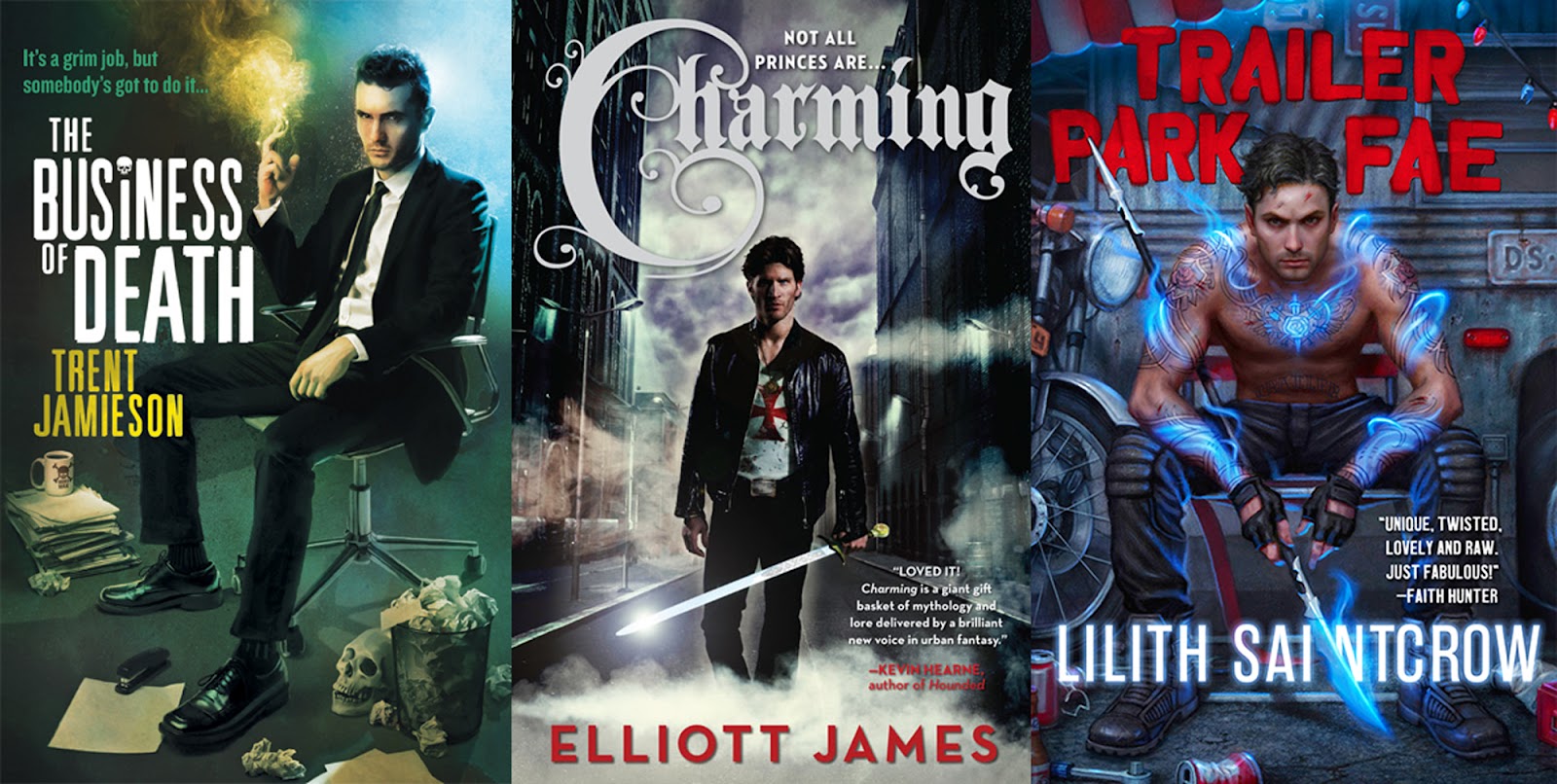 |
| Orbit Urban Fantasy covers with male leads |
It was while working on these covers specifically (and yes, watching Supernatural doing research) when it all clicked for me. A hero character on the cover needs to be both “sexy I want to be” for the fans of that gender and also “sexy I want to $%^!#” for the fans of that sexual orientation. And the key, again, is agency. I kid about being a big Supernatural fan but that show hits this balance perfectly. Women are the dominant fanbase, but there’s a lot of men who are fans as well. The main characters are cool enough for the guys, but hot enough for the ladies.
I’m not here to make enemies, and I’m not here to call out colleagues and artists. So I’m only showing covers I’ve worked on, not trotting out the bad examples. I try to design all my cover characters with agency. The one cover above that has an objectified character is Blood Rights – and she starts the book as a blood slave to a vampire, so I portrayed her that way by choice. Even though I won’t shame bad covers here, I will share the list I have developed of rules about portraying women on my covers, whether they be photography or illustration:
1—No Stilettos. (Also, No Strapless Anything) Sorry, I know SFF is all about suspension of disbelief, but the thought of fighting in anything strapless or balancing on teeny heels is ridiculous. I have made a compromise and allow boots (chunky heels only). I mean, this IS fantasy, right?
2—No Fashion Poses. If possible, no fashion models. Fashion models are beautiful, and they are paid to look and pose a certain way. I try not to judge or body-shame either side of the weight scale, but I like my heroes to look like they can kick some ass. Also, if you look at a lot of the most awkward-looking urban fantasy covers, then look at a copy of Vogue, you’ll see the models are throwing standard fashion poses, elbows akimbo. They just look out of place on a book cover. If possible, I use only fitness models and book-experienced models.
3—Pose Weapons Properly. There’s nothing worse than the sword-as-baseball-bat poses, amirite? And the random (and dangerous-looking) aiming of guns. I have an author friend, Myke Cole, who checks my trigger discipline for me. Recently I had an actual historical fencing expert, Tristan Zukowski, come to a shoot and advise on proper dueling poses. This really gets the models in the mood, and the accuracy makes our shoots so much more bad-ass.
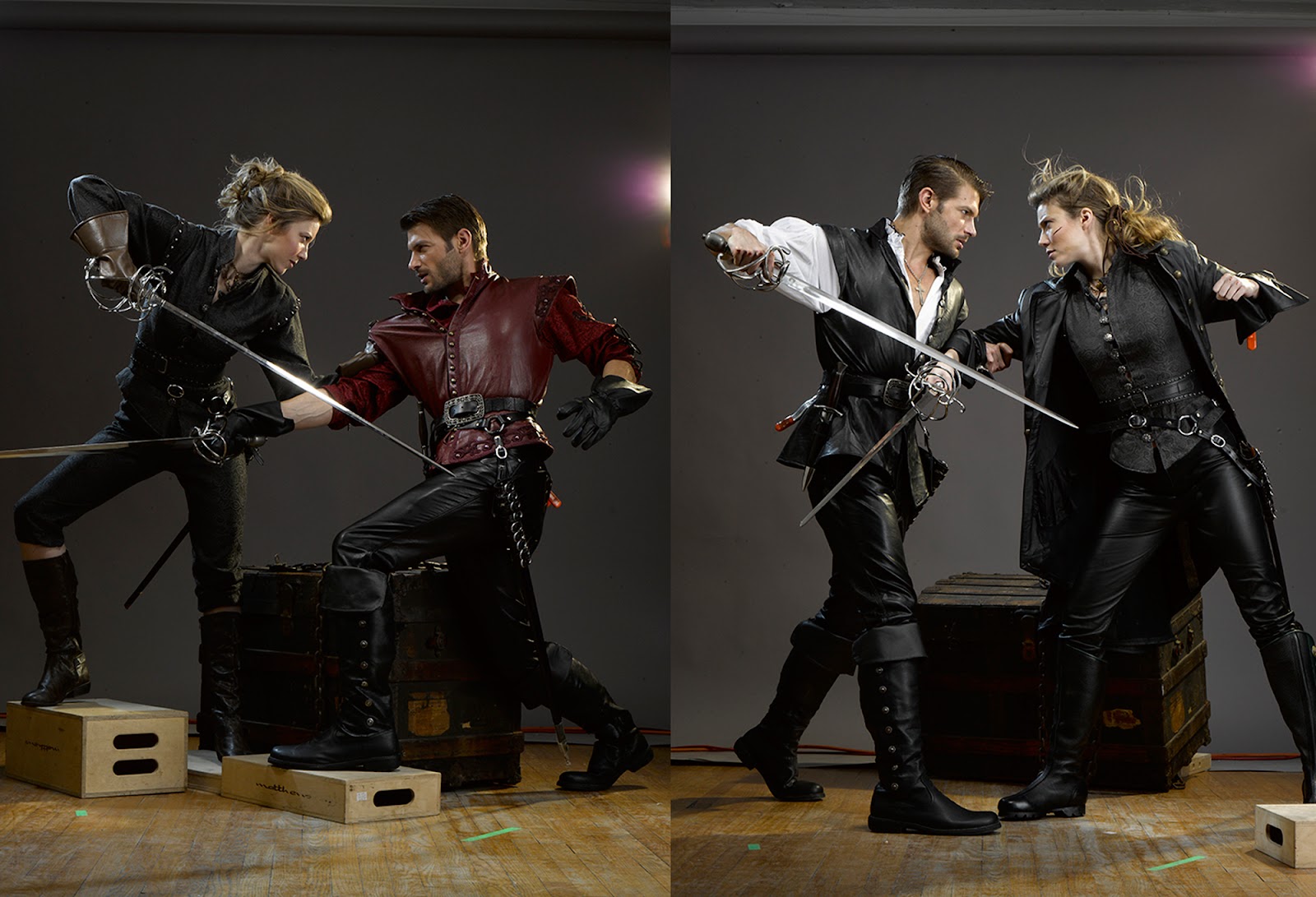 |
| I love these shots so much I can’t wait to see the covers they become. |
There have always been women fans in geek media, way back to the first conventions. Hell, the first science fiction book was written by a woman! So it is disheartening when women feel excluded over and over again in geek media. For a genre that has always accepted the weird, the awkward, the outcast, it’s counterintuitive to me that geeks would want to exclude anyone. I know what it’s like to feel as if your safe space is threatened, and your worth as a specialist with insider knowledge to be challenged. Heck I am a New York City native. If I can put up with the hipster invasion, then geeks can put up with women fans.
I hope this little tour through my brain and process was eye-opening. I hope you can start to feel the difference between sexual and sexualization, because I think the way through this issue of representation is to really know the difference, and know the proper time and place to use both. Remember, the key is to make sure your characters have agency. Agency brings narrative, and the more narrative you bring to your art, the better it will be.
CREDITS! (anything not specifically mentioned is me)
Best Served Cold – photo-illustration by Gene Mollica
Love Minus Eighty – photo by Erin Mulvehill, Design by Kirk Benshoff
Black Ships – Illustration by John Jude Palencar
House of the Rising Sun – illustration by Mélanie Delon
Shambling Guide – Illustration by Jamie McKelvie, Design by Nina Tara
Hot Blooded – Photo by Shirley Green, Illustration by Rob Shields, Type by Chad Roberts
Ancillary Justice – Illustration by John Harris, Design by Kirk Benshoff
Falcon Throne – Illustration by Raphael Lacosté, design by Kirk Benshoff
Black Wolves – illustration by Larry Rostant, Tattoo by Stephanie Tamez
Dirty Magic – photo by Shirley Green, illustration by Don Sipley, type by Chad Roberts
Blood Rights – illustration by Nekro
The Queen is Dead – photo by Stewart Noack, illustration by Don Sipley
Business of Death – Illustration by Dave Seidman
Charming – photo by Shirley Green, illustration & design by Wendy Chan
Trailer Park Fae – illustration by Dan Dos Santos
Duelists photos by Gene Mollica


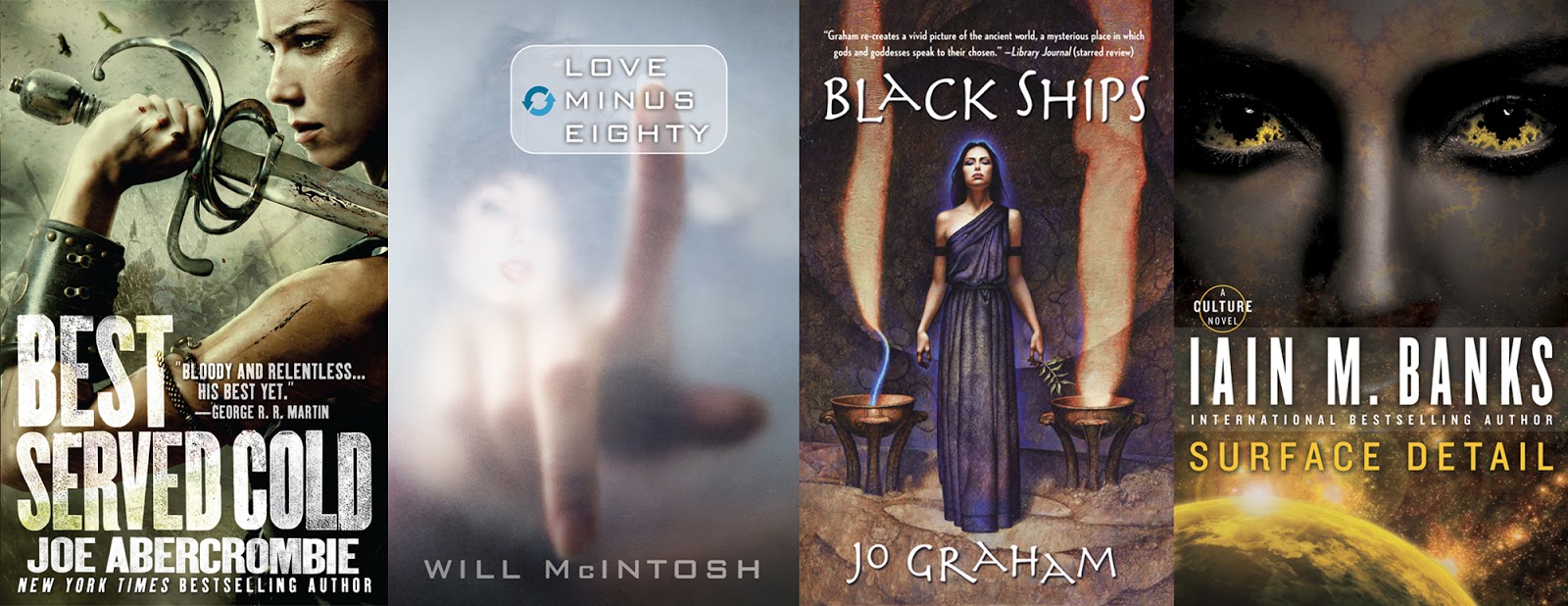
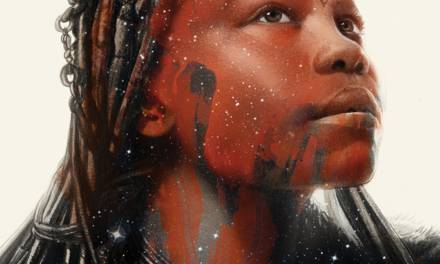
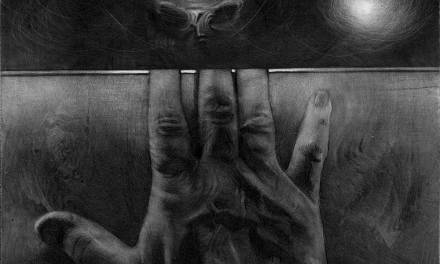
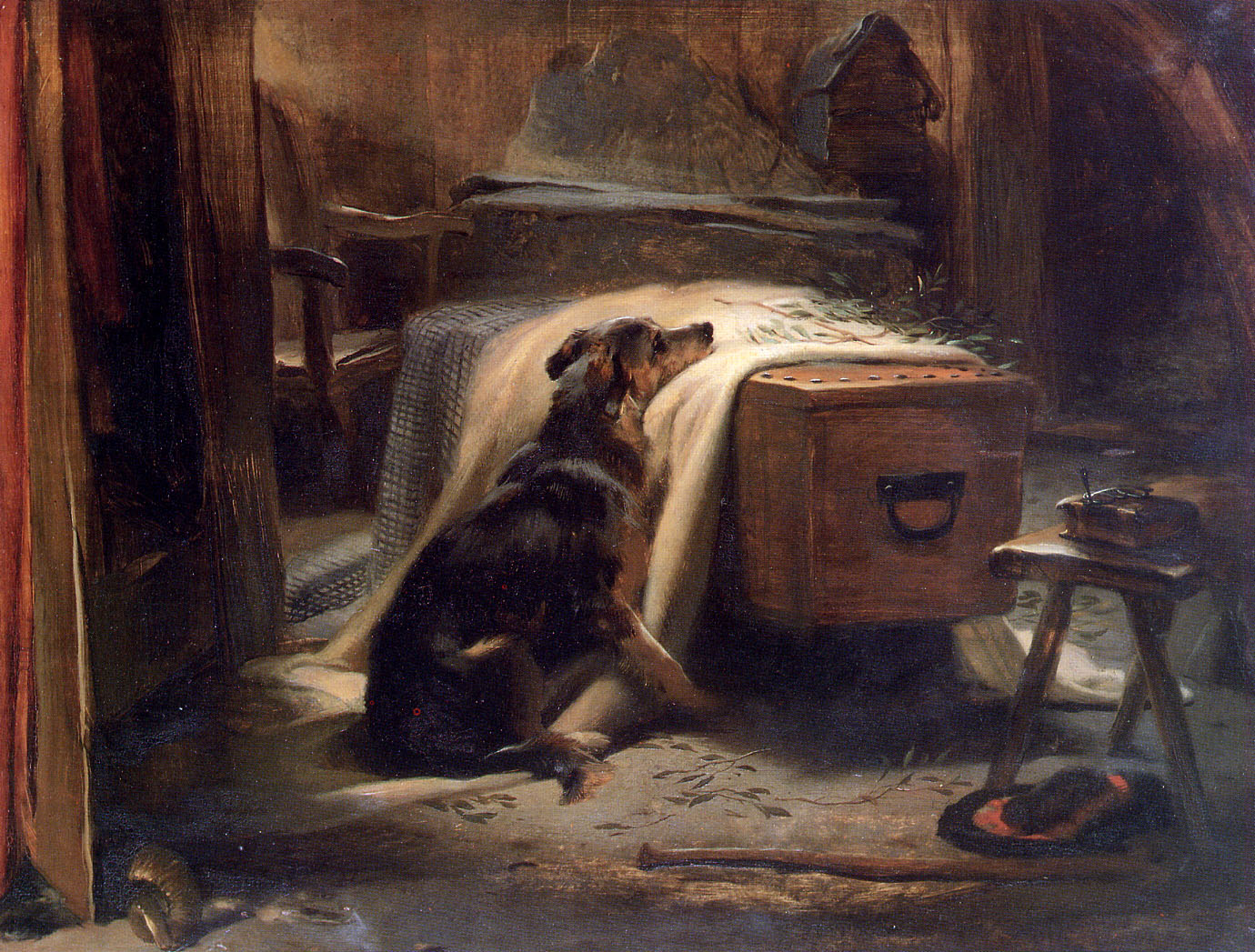
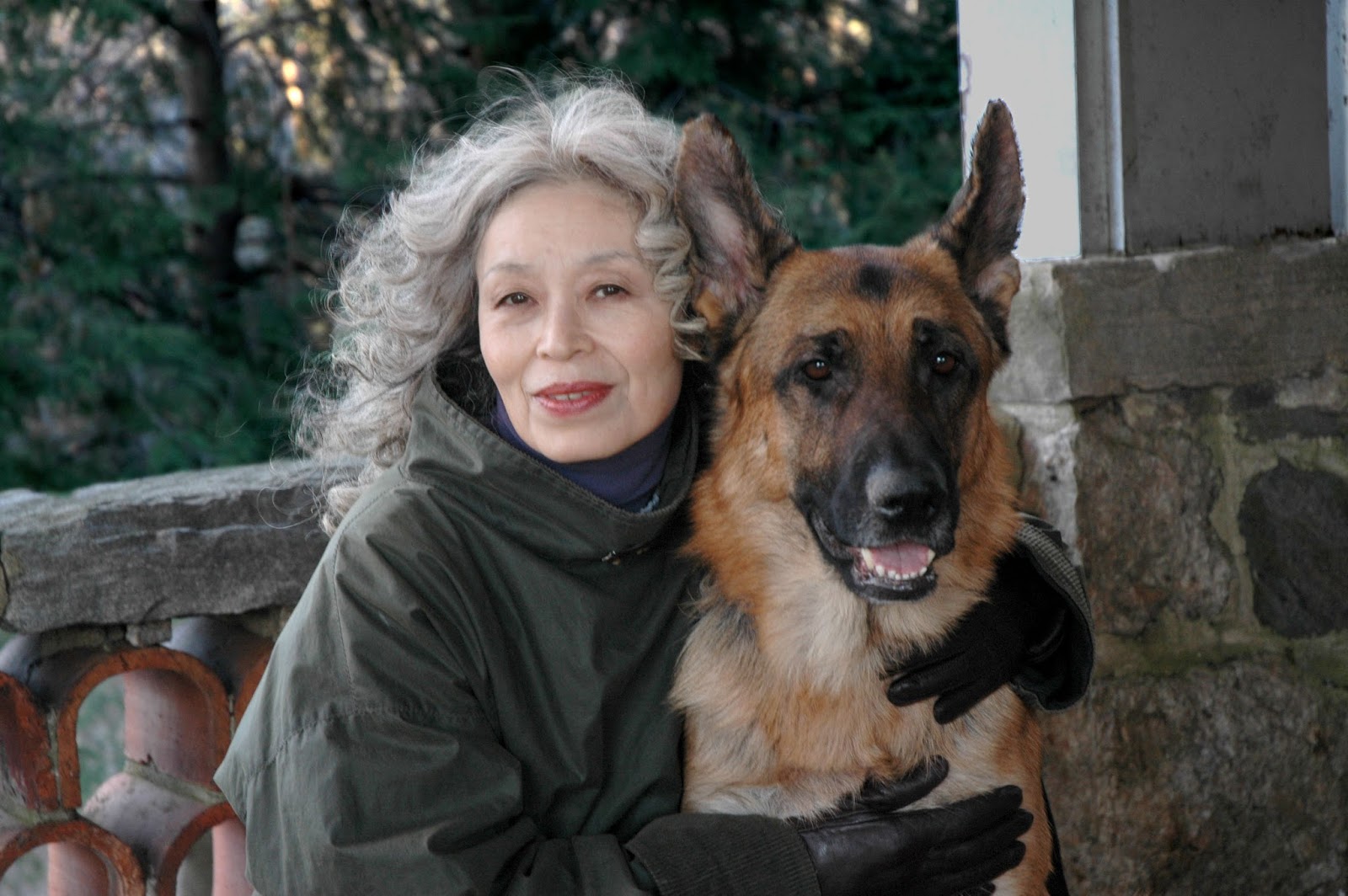
Most insightful…This is why I always look forward to reading your posts. Well done, madam!
Really awesome post, Lauren! Thanks for doing all of these articles… I agree that there's a big moment going on with gender in geek media and this distinction of agency is so critical to that.
Also, your line here: “A hero character on the cover needs to be both “sexy I want to be” for the fans of that gender and also “sexy I want to $%^!#” for the fans of that sexual orientation.”
I think that accomplishing this also works on the level of allowing people to play with embodying people who they don't /normally/ identify as or with. I like stories with leads that are different from my normal experiences… I mean, obviously I'm not a ranger or a plucky rebel or anything to begin with! But I also mean that having a range of genders in lead characters is a plus, for me, since it just enriches the variety of experiences that stories offer. (Then again, my experience of gender is pretty different than a lot of people, so maybe I'm overthinking things, ha.)
Very nicely put, and I'm excited to see the covers for the photoshoot, because those are awesome shots. I've always been very bothered by stilettos on girls who are supposed to run and fight. And, on a related note, I would pull my hair back before getting into an adventure. It's so hard to get things done with hair in your face…
No I absolutely agree. I have always had a pretty normal gender identity as a woman, yet I still identify a lot with male heroes. (the other ADs are laughing now, because I am definitely Dean Winchester in our little Supernatural jokes, but I also have no trouble simultaneously holding a geek crush on him at the same time, ha). I am sure there are guys who enjoy identifying with a female hero but are less vocal in admitting that.
Love the hell out of this introspection and how it addresses things a viewer desires with what makes good art.
Thank you for this Lauren. I can definitely relate! this was a great, insightful post.
As usual, you've offered some great insights. I'm inspired to get cracking on some strong women characters – that is, once I learn how to illustrate better. But hey, maybe I do both.
“maybe I CAN do both” – dang keyboard!
Even better, aim for COMPLEX women characters, whether they're strong or not. Just give them a story.
So very great. What an excellent follow up tot he last one. Keep it coming Panepinto! You're agency has no limits apparently.
Great post but I don't know that I can buy into the Frazetta example.
In both instances demonstrated the women painted are actually presented as sexual fantasies and in both are eventually reduced to objects.
e.g. In one the women are subs & the other they are doms, but both examples demonstrate objects of a male view.
Which is totally fine (as you say sexual fantasies etc) but just because in one they are naked next to a tiger as opposed naked riding behind tiger doesn't really change this in essence. (It only indicates a dom-preference maybe.)
Other than that niggling difference of perspective on art, great article!
PS: No stilettos – Omg yes!
“There are plenty of places for a male POV and enjoyment of sexual objectification. I absolutely do not think those places need to be eliminated.”
This is an interesting curious statement Lauren. I guess the word objectification means different things for different people. But it seems to me that the word has become completely negative such as racism. I can't think of an appropriate place for any objectification of women as I understand the word. So I'd be curious to hear your take.
I absolutely agree that the line between ok & objectified is personal to each person (especially each woman). I find those Frazetta images really empowering, but I understand that not everyone is going to feel this way. I think they still work as general examples tho
: )
Well I think retro style pinup art is objectifying…but i love it. love Milo Manara's erotic comics and those are absolutely objectifying to women. But they're meant to be erotic.
But I also think turnabout is fair play. There was another challenge in that womens art group that was to objectify male characters for the female gaze…they were too NSFW for Muddy Colors but daaaamn some of those were hot.
…..and then there's Robert Crumb.
😉
Lauren, I'm curious to see more of your take on this. I'm trying to tread this line in my own art. I love retro pinups (Elvgren, Betty Page, etc.) but I'm also sensitive to the moving demographics of the genre. I don't want to offend anyone, but more importantly I personally agree that the move away from pure objectification is a long time in coming… (Now if we could just get the comics industry on board! e.g. the recent Spiderwoman cover)
Personally I'm not a big fan of modern “pinup” art in most cases, as it generally crosses the line into much more sexual objectification of women. The older pinups, while yes aimed at the male mindset, had a playfulness and well, ironically, “innocence” for lack of a better word than much of the new stuff coming out today (it's tease vs. crass in my mind.)
Any thoughts on how to balance my own inspirations as an artist vs. not limiting market appeal? For example, I'm doing a series of paintings as retakes on old paperback covers. In some there will be scantily-clad women, though, in keeping with an homage to the genre. My first one is borderline “agency” (to use your term) as the woman has obviously gotten the upper-hand on the male…
I'm completely against any objectification of women, even after reading this I'm still am, because woman are never portrayed in their fulfillness, they are always thin, most times white, always with a body that fits the society's pattern. But I understand that we still are at 2015 and that things wont change in less than more 100 years, I don't believe I will be alive to see this happen.
I also understand that selling is the main objective, and that selling stereotypes is easier, everyone can relate to a stereotype.
That said, are you getting easy because it is like a introduction for feminism or you actually think like that? Because, you know, men's privilege to objectify women should be banished, making woman acting like that (In a much smaller level) is not what should be happening, things will get very bad someday.
So, what you think?
Including objectifying me. THANKS LAUREN.
Hey! You totally have agency in that pose! Look at that scowl!
well. everyone has a line right? crumb has always been a little too gross for me to enjoy.
I'm sorry, are you asking me if I'm not honestly saying how I feel? I do try to simplify arguments as much as possible in my Muddy Colors articles, but I never lie (what's the point of that?) So yes, I do really love some of Frazetta's work. Also your comment about skinny is confusing me, because Frazetta is not painting twigs, nor do I use stick-thin models – I actually state that I go out of my way to use more solid female models. I agree that over-objectification in our culture is absolutely reinforcing body-shaming, and that has to stop.
But I feel like objectification is not, in itself, immoral. I think objectification by default is the problem, and rampant objectification in order to sell things is the problem. However I think there's a time and a place where objectification is ok. Note I am not speaking for all women here – everyone has the right to draw their own comfort line where they want. But if you'll read a few comments up, you'll see I am ok with pinups and erotic imagery because it's being used for a specific purpose. And only if women have the right to objectify men for the same purpose – i think that needs to be a two-way street, and it's not in our culture, and that's not ok.
For example, I had a big problem with Milo Manara's Spiderwoman cover – i didn't think it was the right way to portray the relaunch of a female heroine targeted at an audience of women. However I was fine with the erotic X-Women story Manara had done a few months (?) before, because it was marketed AS a mature book FOR adults, and was considered separate from the normal X-Men books.
Great article, Lauren! I'm gonna link to it anytime someone asks me how I can like pin-up art as a feminist. I've always tried to explain the difference between objectification and empowerment(or better now, agency) but I never feel like I quite get the sentiment across. I love the work of artist's like Adam Hughes and some of Frank Cho's work in comics(And Frank Frazetta of course!)….but then something like Zenescope grosses me out. Kinda like how I'm okay with Power-girl(who would kick the ass of anyone trying to objectify her just for having boobs and generally not giving a flying f*&^ what people think) versus Starfire( Who was allegedly created just made for spank bank material.).
I think denying that we're sexual beings is letting the pendulum swing too far the other way. As a happily married bisexual woman–I like sex, I like looking sexy, I like admiring the aesthetics of the female(and male!) form….what I don't like is sexual as a character trait or the sole reason for a pose. Instead of back breaking submissive poses, I like seeing women owning who they are, kicking ass and taking names. It doesn't offend me if she has cleavage or a skin tight suit(if those make sense for the character)… but a pantie upshot or a straight up boob shot usually does. It almost seems voyeuristic. Like it's not a shot the character herself would have chosen.
I've thought before about doing a series of sexy female pinups from a female perspective…buuut I want to eventually work in children's illustration, so it probably wouldn't be the best career move. XP
Well, as you can already see from the variation of comments here, different women feel comfortable with different levels of sexiness in their depictions. I think no matter what you do, you're going to offend someone, so I would advise you to a) make sure the women have agency, have a story of their own, in the piece, not just have them be objects or ornaments. b) show thumbnails to a lot of female friends before you get too far into a piece and if most of them say you're ok, then you're probably ok.
A very well-written article, and it's especially nice to see the Frazetta paintings used to illustrate that it's not about prudery, but agency.
Also great to see the emphasis on context.
I have to express my admiration for you and the others who are taking the time to keep engaged with the issue and the discussion, no matter how long the comments threads get.
Lauren, you have really been a great addition to the Muddy Colors blog. I agree with the main point of your last two posts, and obviously you've struck a chord with the topics, but I want to make a different point about something that you've also done and which is part of the great appeal of Muddy Colors in general.
In spite of the fact that you've had some negative or at least challenging responses to your posts, you have responded in a respectful, engaging manner. What you haven't done is use a sarcastic, snarky tone or insults to shame the person responding negatively, but have generally treated them as someone worthy of a response, even a conversation. And that's also true of other Muddy Colors bloggers and commenters.
I'm not saying it's all been perfect, but when someone has crossed a line, or posted or commented in a way that might offend others (sexism or sexuality, anti-religious comments, partisan politics, etc. just to name a few examples) in general the MC community has been restrained in its responses. And that is SO refreshing.
The default approach on so many message boards, comment sections, blogs, etc. is to preach to the choir and insult, shame, and criticize those who don't agree. The world view behind this approach seems to be that those who don't think as I do are either stupid or bad people, and should be shunned and driven out. I choose to ask, what does this person think or believe, and how does that inform their world view?
We should not tolerate trolls, outrageous insults, and abuse, but there is a big difference between that and honest differences of opinion. I like what you've done in a few cases when someone has been quite aggressively negative to you, which is to respond strongly but respectfully. I've seen this result in a few folks apologizing for their tone, and others going silent. That may not be because you've won them over to your side, but just because they felt heard and didn't have anything else to say.
In any event, this positive tone is one of the things I like most about MC, and your posts, even though I do not agree with everything you've said. Count me as a Lauren Panepinto fan.
Well said Lauren, thanks for that!
A sensible and rational analysis. I'm actually tempted to send a link along to my art page and see what art fits under your criteria or not? I get mixed reviews. Most women like the way I portray women. I also use models who have body types fitting the weapons and armour I put them in. I can't think of any time when I've drawn a lady helpless or in need of rescuing though.
I agree, I fall more on the comfortable-with-sexy scale, but I have to remember that not all women feel the same, and that's ok too.
well it's these kinds of comments that keep me going, thank you!
Thanks! That actually means a great deal to me (especially because I've been called out a few times in the last post for being nasty, and I was kind of shocked. If a supernatural gif or two for comic relief isn't allowed there's no hope for me).
I take the time to respond even to the really nasty/aggressive ones because I'm not really answering them, I'm responding for everyone else reading the thread. I'm extremely protective of this community and this blog and I will not stand for disrespect. People don't have to agree with me (god it would be so boring if everyone just said yes, you're absolutely right all the time) but they have to respect me for putting the effort in to write it.
Next I'll figure out a way to actually rig the comments so you're not allowed to comment until you've actually read the whole post, and then truly the internet will be a more wonderful place : )
You know, I don't think you're ever going to be able to please everyone. That said, just make sure your characters have a story (and once in a while that story might even be that they need rescuing) but just don't ever fall back on clichés and tropes unless you're using them consciously for a reason. Then you'll be fine with me.
I'm not Lauren, but I've got a good guess, Bill. The Playboy Mansion. 😉 No one has any illusion as to what the deal is over there. The women are just as complicit as guys in the objectification game. So maybe that's part of the equation? (I'm actually being serious here…pretty much, anyway!)
Absolutely. 🙂 It's all a matter of personal taste and boundaries.
At first sighting, my mind went to the left-handed (gauche)knife blade for rapier duels, not the high heels! Now I have an image of the group, KAZAKI, in high heels duelling. Thank you for both!
Can't it be true that even if women are complicit it can still be objectification?
Whoops! I'm sorry I answered on my phone and it actually didn't reply, it's below as a new comment. I said: Well I think retro style pinup art is objectifying…but i love it. love Milo Manara's erotic comics and those are absolutely objectifying to women. But they're meant to be erotic.
But I also think turnabout is fair play. There was another challenge in that womens art group that was to objectify male characters for the female gaze…they were too NSFW for Muddy Colors but daaaamn some of those were hot.
Ohmygod, a software that wouldn't allow you to comment until you had read the article or visited the link would change the world!
Hi Lauren, you said that you grew up with mixed messages because of superheroines fighting crime in “bathing suits”. I'm not really seeing how giving characters agency “unmixes” the message. It seems to me as if you identified a problem, offered a way to improve the situation, but are still left with “bathing suits” that are still a “direct contradiction to how strong or smart they [are]”.
I can understand how a woman who has agency and dresses in a “bathing suit” may do so of her own will, and takes charge of her sexuality. But I struggle to imagine a situation where fighting crime/evil in a bathing suit makes sense; it almost always seems to me as if her dressing in little clothing has more to do with an aesthetic that the artist/writer wishes to create than with her active choice. (I mean, when I think about how I want to feel confident, or powerful, or ready to kick ass, going outside with very little clothes on has never really crossed my mind. Maybe I'm in the minority, I don't know.)
Oh your posts always seem to generate a lot of responses! Very thoughtful ones by both you and your readers. Tough to know where to jump in here. I was going to at Bill's comment but ended up here.
Having grown up with four sisters and no brothers I was always a little uncomfortable with female objectification (it comes with the territory) and even more so now with two daughters but at the same time can relate to your view of Milo Manara's erotic comics. I agree those are meant for adults so maybe they are separate from more mainstream stuff. And we are sexual beings.
And relating to your point at Bill's comment and Rachael's here on the female perspective how about the artist Olivia?
Hers was the female perspective and some were quite sexual, going beyond pin-up. I remember reading an interview of her years ago and she said something along the lines of some of her illustrations were of/from her female (sexual) fantasy point of view.
I think the appeal was she could be sexy, even erotic, without objectification even when being mildly explicit. A fine line to walk.
And to Rachael, too bad we live in a world where you would have to choose one or the other, pin-up or children's illustration.
We should be able to have adult careers and family ones too without having to worry about repercussions.
It's how our personal lives are.
I think that this goes back to the subject of “context” and maybe history (or tradition). The original concept of superhero garb came from the late-18th-early-20th Century costumes of carnival, circus, and vaudeville performers: the single leotard or swimsuit-type outfits were meant to heighten the perception of athleticism and free movement (helpful when fighting evil-doers). The outfits helped to signify as simply and quickly as possible that these characters were different from we mere mortals. If Batman had traded punches with the Joker in practical street clothes sans cape and cowl…it wouldn't have been Batman
And, certainly, many of the women superhero's outfits, past and present, were also deliberately designed to heighten the character's sexuality: the original target audience for comics was boys entering puberty and was later expanded to include WWII GIs looking for diversion from the battles in Europe and the Pacific. The costumes, whether utilitarian, silly, or sexy (or exploitative,
depending on your point of view) became the visual tropes, the symbols, of the genre—and that's not going to change, at least when it comes to the most popular characters. Why? Because that's part of those characters' stories, their agency. Obviously, there are always variations and always new views or spins that can be applied, but changing a character's appearance too much often kills the readers' interest—which is why things stay as they stay and why new characters are created that reflect different views and sensibilities.
Oh, and for anybody interested, I had a post about objectifying and perceptions in regards to SFF covers a couple of years ago that discussed some of these topics:
http://muddycolors.blogspot.com/2013/03/objectify.html
I agree, I don't think a woman fighting crime in a bathing suit makes sense. But I also think that occurs to girls naturally, and guys usually don't think about it. Kind of like I don't think about something that would be uncomfortable with testicles, but I get an ache in my boobs when I see some ridiculous superhero getup that would be too uncomfortable to fight in.
I think this conversation is important, because for the properties that ARE being targeted at women audiences, that's when these changes will take effect – and ARE taking effect. Babs Tarr's Batgirl redesign is an amazing example. That book was relaunched to appeal to a younger female audience, and her character design absolutely takes that into account. The recent controversy over the Joker cover just proves that you can't blindly make decisions without taking the target audience into account.
I don't think we need to change all of comics. But it is absolutely time that women have a place within comics that is absolutely theirs, where their desires are respected. And I think there's ways to respect tradition while also moving forward. Wonder Woman is a great example. I can't imagine fighting in a strapless bathing suit, but I'm not going to suggest that we redesign Wonder Woman completely. (for the record I don't like the new version…not because I don't like her covered up, but because all they did was cover up, not really redesign the costume in a way that made sense as a whole. But again, WW has so much tradition it's a tricky one.)
@Arnie: Thanks for the explanation. I didn't know about that context. Also thanks for the link; I'll read that through shortly.
@Lauren: I didn't say this in my above post, but thanks for writing this up. It addresses some of the things I've been wrapping my head around as an artist in the video game industry. On the one hand, I want to be free to express myself artistically, and draw sexualised men and women if that's what I wish to draw. But on the other hand, I've seen the negative effects in the form of poor body-image, low self-esteem, and other related issues manifest in my friends and past girlfriends. And while I think that magazines and advertising are by far the biggest culprits, that doesn't absolve the rest of us from responsibility. I've just been trying to figure out where I draw the line, where I don't feel as if I'm being censored, but where I'm also able to create work that my conscience is comfortable with.
And I've found the conversation around these topics to be very polarising. Each side seems to paint the other as extremist loons, and set up a bunch of strawmen, instead of genuinely trying to engage, understand and explore.
I look forward to reading more of your thoughts.
– Elya (just changed my Blogspot name to my real name and found that it didn't update my above post)
Jonathan–You're welcome. And, just to be clear, I'm not saying that comics (or any aspect of culture) shouldn't change or making excuses, but simply explaining a little where and why.
Lauren–I, too, love Babs Tarr's Batgirl redesign. That the controversy erupted over the Joker variant cover, I think, reinforces the main points of your posts: know your audience and make the art be true to your characters. Not advocating censorship but championing thought.
Girls should draw the ever they want to same as boys, art is freedom, if you want to draw a girl with high heels just draw her, if you want to draw a clothed girl with a chained nude on his knees man just do it. Dont limit yourself in art, just express it.
No, I wasn't calling you lier at all. When I spoke about objectification, I speak on my country perspective, different from yours and extremely different from Frazetta perspective, sorry about that.
So, I agree with you, but I'm horrible with words, so please read the The Beauty Myth you will understand what I'm trying to say, it's a great book and gives a great perspective of how the female image is treated and how it turns against us (Even if we can objectify men too)
Thanks! Good advice. I always show my work to my wife anyway, who isn't shy about telling me what she likes/doesn't like… 😉 She's also an artist, though more on the fine art spectrum, but we have shared genre interests (RPGs, comics, fantasy, scifi) that make her a good sounding board regardless.
Yes and I love that article! so sad I forgot to link to it in mine! Here's the direct link to Objectify
And I think Dan Dos Santos's art is a great place, like Frazetta's, where people have very different reactions. I think Dan's women, tho very sexy, are usually very strong and have a lot of agency. But I know other people feel very differently.
Half of an image is what the viewer brings to it, which is why these conversations are so hard.
No one is saying artists shouldn't draw what they want. I'm actually saying just to think about why you want to draw it, and make sure there's a good reason. It'll make your art 500% better.
Yeah i can agree that some parts are sexy forced, i really love when i see storytelling on a piece, but i cant agree on high heels, even in action, because its a fantasy. Im tirted that lately they want hyper realism in everything, for example latest armor in Batman, or doing every singe superheroe into a black outfit, because a yellow with blue its not “real enough”. Dont agree in 500% better. Its like saying dont do rap music and do more classical music, why rap should be forbidden, you can say the music would be 500% better if rap doesnt exist, But i think there are different markets and peoples and creativity. i like your rule, but rules can be broken, that why i love art.
Even if we have a bit of differences i loved your post, always cool to see other peoples view, is good that you share tips and take most of your precious time to post this to help us improved, i just replied back to stop confussion or something, i really enjoy points of views of females, but agree i will start toning down the sexual thing, but lets not get crazy there, hhahahha looking forward to your next post. Have a lovely day.
The way I look at objectification:
We see a person at a distance and we are attracted to them because of what they look like – this is fine, this is how humans work, this is how babies (eventually) get made, totally healthy. Art which keys in to this function is not problematic in and of itself for any gender.
HOWEVER
There is a MASSIVE body of art/media which depicts men as *other things too*. Examples of men being brainy, powerful, caring, etc abound and the appearance of the men in those media will typically match the role being portrayed.
I don't need to be reminded that the shirtless beautiful man in a print cologne ad could also be powerful or smart because the portrayal of men as powerful and smart is a norm in our society. The facing page on the magazine may just as easily portray an older man in a board room with an expensive watch. People in media will always be attractive (ie regular featured, clear skinned) but men don't have to be sexy.
Other than breeches of situational appropriateness (a senator at a podium in sweats would raise comments, but they wouldn't be about his butt) the appearance of men in powerful positions is not a central point of discussion.
Men in media are telling dialogues of both FOR and ABOUT.
Women however? That's another story entirely.
Women in visual media overwhelmingly exist to be non-threatening eye candy*. This wouldn't be so much of a problem if we also had a wealth of balancing stories where women are used to show strength, intelligence, and leadership. Or even if the women who already ARE working to show those qualities weren't continually dragged down to a superficial level.
The fight against objectification is not a fight of removing sex from the equation entirely, but of adding other stories in.
As it is, women in media are FOR.
*one caveat, women are also commonly depicted as non-threatening care givers (the dishwashing mom, the ironing wife), but this is still a dialogue of service.
I have, it's a great book. I understand there was a language difficulty there, no prob.
Actually, I think from seeing your rap metaphor, you're not getting what I mean at all. What I AM saying is, absolutely do rap music if you want. But don't do it because you think it's trendy, or because it's the default, or because it's what you learned first. Chose rap music because it's the medium that let's you say what you want, in the way you want to say it. Try rap, and classical, and country, and if you decide rap is the best medium, go for it, but the EXPERIENCE of trying other things will make your rap music 500% better.
Lauren,
Absolutely fantastic piece here. I consider myself a feminist and as an art director for board games, I'm generally pretty proud of what ends up on our stuff. There is, however, one piece of art I've always struggled with…
Wally Wood's SPACEMEN magazine 1965 cover art seen here:
https://s-media-cache-ak0.pinimg.com/736x/30/cc/46/30cc4668460bcc429ae9e19f7b52d403.jpg
I have a poster of it framed in my office. I mostly understand agency and objectification, and maybe it's just my nostalgia clouding my judgement here, but is this a sexist piece? I don't want to appear hypocritical to the artists and clients I work with. Thanks for your input!
Haha, i think that is pretty tame as far as objectification goes. Yes, it's objectification. The women are props, not characters…but as I've said above, there's a time and a place that that's ok, and I am not offended at all by this one. It's a personal reaction, of course, so maybe other women feel different, but I don't think hanging it in your office is offensive.
Great interview with Erik Larsen…. really on point.
http://www.reaxxion.com/6512/erik-larsen-speaks-on-online-outrage-women-in-comics-and-sexist-costume-designs
THANK YOU for respecting Frazetta. I'm so tired of the ol' “Sexy equals sexism” argument thats ruining Feminism as of late. Feminism isn't about eliminating femininity from characters or prudery. I'm going to fave this article as good research. cheers
(sorry if this is a double post, google is hard to predict)
I finally get to say this to a real live art director. First I will confess that I'm an illustrator. I never ever ever buy fantasy novels with photos of characters in costume. I find them astoundingly silly. Embarrassing even. I'd be very self conscious being seen reading something with such a cover. I'm sure it's just me….
The problem we're balancing here is that an image can never have a complete story, even a book cover. It can be a springboard, but the rest is completed in the audiences mind.
Also, I apologize if I missed you saying this but I really want to point out that IT IS POSSIBLE for someone to be empowered by a character of the opposite gender, regardless of orientation. And this happens quite often then most people think.
I get what you are saying. I want to say some things related to the topic.
Make the characters your audience wants to buy. Period. Don't put ideology into it – I am wary of this, especially from the isms and ists, because they are imposing and authoritarian, and willing to lose market fitness because of this. Don't think everyone wants the same thing even as markets change. Male, female, different ages and backgrounds all people want different things, and it's all valid. It's not possible for fictional characters to have agency, because they are not real people, they are fiction, and not everyone wants characters with “agency” as in having power of their situation. Many interesting characters have little power, they struggle, they go through harsh situations over and over. For story, for actually strong characters, this can all be good. It is possible for characters to have appeal, for whatever traits they have. The word “appeal” is more appropriate than “sexy” when you are marketing characters to audiences.
It's false to say women feel excluded without saying it's not all women. Some might. Some men might too, who do not find it appealing at all. What about them? They do exist. Women have been creators along with men since the beginning, making what they want for themselves and for other like minded people. It is a false narrative to think otherwise. It's okay for people who make things primarily for themselves to appeal mostly for themselves. It's not okay to bully creators to appeal to others just to be more inclusive. It is good to encourage new audiences to create content for themselves, they would know best what they life after all.
No matter what you do you cannot make everything perfectly “inclusive” for everyone. By putting more clothes on your females you may make a cover more approachable to more conservative minded women, but there are women who are sexually attracted to “sexualized” sexy women, there are women who want their fantasy to be a sexy female character without traditionally masculine traits, and to ist and ism minds might think are horribly objectified and sexist characters, even when designed by women. There are many market segments and all should be respected not attacked. Anyone who acts like an authoritarian to impose on audiences what they personally think they should like will find that their audiences buy elsewhere.
It's complex. The world is big. Markets are big. There is a lot of potential for new markets and new audiences, but you should not try to appeal to everyone, you should make the best product for your audience, and that includes your characters.
Put your audience first, don't let ideologues bully you, do what your paying customers pay you for. And I agree with you to not assume things about audiences. If you feel your rules make product which most appeals to your audience that are buying then you are doing it right. There could be other sets of rules to appeal to other demographics, even different women than the ones you are targeting to appeal to with your rules.
“Naked ladies as trophies, prizes, ornamentation. They don't have stories, they are objects that the action happens to”
That is one way of interpreting those images only. There are more ways to interpret them too, such as the female characters using sexualized appeal to get the male characters to act on their behalf and protect them. Do you see this interpretation there too? It is there. A lot of women really dig this kind of role too and don't see it as bad thing, but something they may find an appealing fantasy. They may say in their fantasy “I want to be like those women… I want a man like this to be mine” and that is compelling to them. The ists and isms hate these women and do not see their desires as valid, and people who listen to ists and isms lose market fitness by sticking to ridged ideology, religion, politics. So it's about markets, not one rule (or three) to rule everyone.